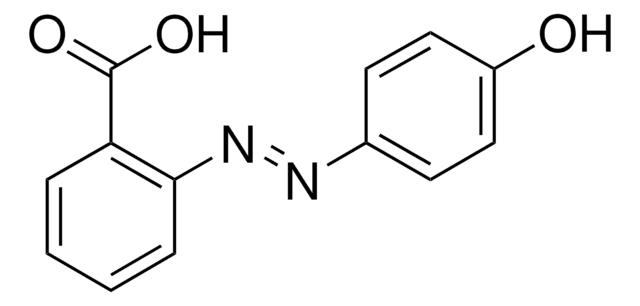54793
2-(4-Hydroxyphenylazo)benzoic acid
matrix substance for MALDI-MS, ≥99.5%
Synonym(s):
2-(4′-Hydroxybenzeneazo)benzoic acid, 4′-Hydroxyazobenzene-2-carboxylic acid, HABA, HBABA
About This Item
Recommended Products
grade
matrix substance for MALDI-MS
Quality Level
Assay
≥99.5% (HPLC)
≥99.5%
analyte functional class(es)
polymers
analyte chemical class(es)
glycans, peptides, proteins
technique(s)
MALDI-MS: suitable
mp
204-208 °C (lit.)
204-208 °C
solubility
ethanol: 20 mg/mL, clear
cation traces
Ca: ≤10 mg/kg
Cd: ≤5 mg/kg
Co: ≤5 mg/kg
Cr: ≤5 mg/kg
Cu: ≤5 mg/kg
Fe: ≤50 mg/kg
K: ≤50 mg/kg
Mg: ≤5 mg/kg
Mn: ≤5 mg/kg
Na: ≤100 mg/kg
Ni: ≤5 mg/kg
Pb: ≤5 mg/kg
Zn: ≤5 mg/kg
absorption
≥2000 at 337 nm (mol. absorption)
SMILES string
Oc1ccc(cc1)\N=N\c2ccccc2C(O)=O
InChI
1S/C13H10N2O3/c16-10-7-5-9(6-8-10)14-15-12-4-2-1-3-11(12)13(17)18/h1-8,16H,(H,17,18)/b15-14+
InChI key
DWQOTEPNRWVUDA-CCEZHUSRSA-N
Looking for similar products? Visit Product Comparison Guide
General description
related product
Storage Class Code
11 - Combustible Solids
WGK
WGK 3
Flash Point(F)
Not applicable
Flash Point(C)
Not applicable
Personal Protective Equipment
Choose from one of the most recent versions:
Certificates of Analysis (COA)
Don't see the Right Version?
If you require a particular version, you can look up a specific certificate by the Lot or Batch number.
Already Own This Product?
Find documentation for the products that you have recently purchased in the Document Library.
Customers Also Viewed
Our team of scientists has experience in all areas of research including Life Science, Material Science, Chemical Synthesis, Chromatography, Analytical and many others.
Contact Technical Service






![trans-2-[3-(4-tert-Butylphenyl)-2-methyl-2-propenylidene]malononitrile matrix substance for MALDI-MS, ≥99.0% (HPLC)](/deepweb/assets/sigmaaldrich/product/structures/249/587/f8021369-f65a-413d-887d-3c8a4d2a248f/640/f8021369-f65a-413d-887d-3c8a4d2a248f.png)




